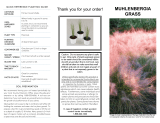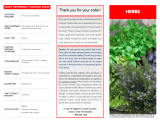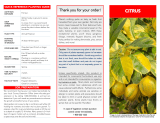Page is loading ...

**IImmaaggee oonn ccoovveerr iiss rreepprreesseennttaattiivvee ooff tthhee ttyyppee ooff ppllaanntt((ss)) iinn tthhiiss ooffffeerr aanndd
nnoott nneecceessssaarriillyy iinnddiiccaattiivvee ooff aaccttuuaall ssiizzee oorr ccoolloorr ffoorr tthhee iinncclluuddeedd vvaarriieettyy
.
Silver Dollar
With a reliable harvest of plump blueberries and
an eye-catching visual effect, blueberries dazzle
in the garden year after year! Remarkable
foliage shimmers with shades of pink, green,
and turquoise throughout the spring and
summer months, then change to fiery red in fall.
Blueberries are excellent for containers, so you
can enjoy their beauty and harvest fresh berries
on your patio, balcony, or deck.
Caution: Do nnot aassume aany pplant iis ssafe tto eeat.
Only pparts oof pplants eexpressly ggrown tto bbe eeaten
should bbe cconsidered eedible. AAs wwith aany pproduct
that iis nnot ffood, ccare sshould bbe ttaken tto mmake
sure tthat ssmall cchildren aand ppets ddo nnot iingest
any ppart oof aa pplant tthat iis nnot eexpressly ggrown tto
be eeaten.
Unless specifically stated, this product is
intended for ornamental horticultural use only
and is not intended for consumption or ingestion
by humans or pets. Most plants are harmless
but some contain toxic substances which can
cause adverse health effects. Furthermore, some
individuals and some animals are sensitive or
allergic to certain plants and precautions should
be taken to limit or avoid physical contact with
particular plants. Some plants have thorns or
spines that can be painful if handled.
In ccase oof iingestion ccontact aa ppoison
control ccenter iimmediately.
1-8800-2222-11222
Full to part sun.
LIGHT/SUN
EXPOSURE
USDA HHARDINESS
ZONES
PLANTING
DISTANCE
IN-GGROUND
MATURE
HEIGHT // SSPREAD
Silver Dollar 3 feet tall and wide
Silver Dollar 5 to 10
Spring.
BLOOM TTIME
TIME TTO RREACH
MATURITY
PLANT TTYPE
Perennial.
CONTAINER SSIZE
One plant per 12-inch or larger
container.
12 to 24 months.
QUICK REFERENCE PLANTING GUIDE
Thank yyou ffor yyour oorder!
At least 5 feet apart.

VARIETAL INFORMATION
FFEEEEDDIINNGG
Feed your plants once every 2-3 weeks during the growing
season with a water soluble fertilizer for acid-loving plants.
Discontinue feeding after September 1st so your plants
can harden off for winter dormancy. Resume fertilizing
when new growth appears in spring.
PPRRUUNNIINNGG
HHAARRVVEESSTTIINNGGWWIINNTTEERRIIZZIINNGG
Watering thoroughly in late fall will greatly enhance your
plant's cold tolerance once the ground has frozen.
Blueberries should be winterized in late fall. When winterizing
your plants, keep in mind that the root system is the most
vulnerable to cold damage. Mulch heavily by mounding a
6-8 inch layer of loose soil, shredded bark, compost,
leaves, straw or other organic material around the base of
each plant.
In very cold areas, containerized plants can be brought
into an unheated, protected area such as a garage or
cellar before temperatures drop below freezing. Check
soil moisture every 2-3 weeks and water as needed during
winter.
In spring, remove mounded soil or mulch from in-ground
plantings. Containerized plants should be moved back out
into the garden sunlight where they will begin to repeat
their yearly garden performance.
CONTINUING CARE (Continued)
Important:
Thoroughly hydrate the plant by submersing the root
zone in a container of water for 10 minutes while you prepare for
planting.
1. Remove and discard the clear plastic bag from around the pot.
2. After watering, remove the pot by holding the plant upside
down in one hand and squeezing the sides of the pot with the
other.
3. Prepare the root ball for planting by gently disturbing the surface
roots with your fingers, fork, or gardening tool and pruning any
damaged roots. This will encourage the roots to begin growing
outward into the new soil.
4. Dig a hole twice as deep and twice as wide as the plant's root
ball. Partially backfill the hole with soil and place the plant into
the hole. The top of the root ball should be level with the ground
surrounding the hole. Refill the hole with soil, firming the soil
around the plant with your fingers. Check to be sure the plant is
not planted too deeply. If it is, raise the plant carefully and re-
firm the soil.
5. Water thoroughly.
PLANTING INSTRUCTIONS
CONTINUING CARE
Remove any dead or damaged growth as needed to
maintain a healthy, attractive appearance. In early spring,
remove any canes that have become old and unproductive
to encourage the plant to devote its energy to the fruiting
canes.
Adequate and consistent watering is essential during your
plant's first year in the garden. Infrequent, long soakings
of water that thoroughly saturate the soil are more effective
than frequent, light applications of water.
Due to variable geographical and environmental conditions,
a specific watering schedule is difficult to define. However,
as a rule of thumb, you should not allow the soil or the
original root ball to completely dry out. During the first
summer, you may need to water as often as every few days
in periods of drought and extreme summer heat. To
determine if your plant needs water, dig a few inches into
the soil next to the plant. If the soil is dry 2-3 inches below
the surface, it is time to water.
Overwatering can be as damaging as under watering. Be
sure that the area surrounding your plant has adequate
drainage to move water away from the plant. If you choose
to plant in a container, always select one with drainage
holes to prevent your plant's roots from sitting in water.
WWAATTEERRIINNGG
Apply a 2-4 inch layer of shredded bark, compost, leaves,
straw or other organic matter around your plants to promote
moisture retention, maintain even soil temperatures and
discourage weed growth. Replenish the mulch as needed.
MMUULLCCHHIINNGG
Keep the area around your plants free of weeds. Weeds
compete with surrounding plants for food, water and light.
Walk around the garden periodically and pull weeds,
including the roots, as soon as you see them.
Pick blueberries when the fruits have changed from green
to blue but still feel firm. After picking, store the berries in
a refrigerator and do not wash them until you are ready to
use them. The sweet, nutritious berries can be eaten fresh,
preserved or used for cooking. Do not consume any other
part of the plant.
WWEEEEDDIINNGG
OUT OF THE BOX
Your plants have been shipped to you in pots. Please remove the
plants from the packaging right away and plant them as soon as
possible following the planting instructions below. If it is not
possible to plant them right away, follow these important steps:
1. Roll the plastic down around each plant and place them in a
sunny location.
2. Keep the plants well watered.
Note: Some leaves may appear wilted or yellow upon arrival. This
is due to the stress of shipping and is nothing to worry about.
Water the plant and let it recover for few days, then gently
remove any foliage that does not recover to allow for new
growth.
BLUEBERRIES
SHIPPED AAS SSHOWN
A chill hour is equal to one hour a plant spends in temperatures
ranging from 32-45°F. The amount of chill hours required varies
between varieties. If a plant does not experience enough chill
hours during winter, its flower buds may not open in spring.
Cross PPollination:
the transfer of pollen from one flower to another
of a different plant within the same species.
Self-PPollination:
the transfer of the pollen from the anther to the
stigma of the same flower.
Rabbiteye:
low chill hour requirements; requires cross pollination
Northern HHighbush:
high chill hour requirements; self-pollinating
Southern HHighbush:
low chill hour requirements; self-pollinating
Alapaha:
Rabbiteye; 450-500 chill hours
Brightwell:
Rabbiteye; 400 chill hours
Farthing:
Southern Highbush; 100-300 chill hours
Meadowlark:
Southern Highbush; 200 chill hours
Pink LLemonade:
Rabbiteye; 200 chill hours
Powder BBlue:
Rabbiteye; 550-600 chill hours
Premier:
Rabbiteye; 500-550 chill hours
Sunshine BBlue:
Southern Highbush: 150 chill hours
Top HHat:
Northern Highbush; 1000-1200 chill hours
Vernon:
Rabbiteye; 500-500 chill hours
/








